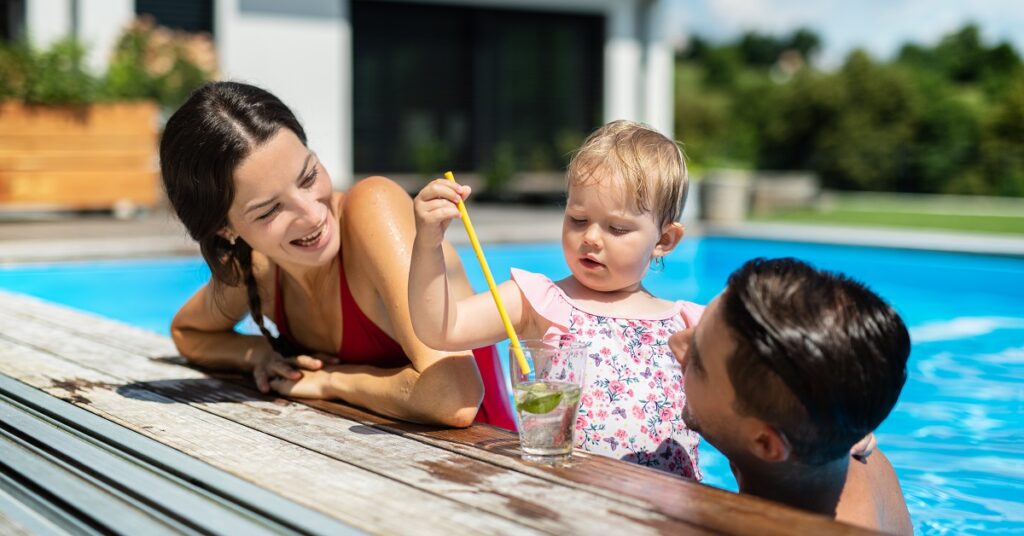Above Ground Pool Liner Talk, Inground Pool Liner Talk
The Professional’s Guide to Above-Ground and Inground Pool Liners
Welcome to “The Professional’s Guide to Above-Ground and Inground Pool Liners.” This comprehensive guide will provide you with all the essential information you need about liners for above-ground and inground pools. From the basics of what pool liners are and why they’re important to the various types available and how to choose the right one for your pool, this guide has you covered. So, whether you’re a seasoned pool owner looking to upgrade or a beginner embarking on your first pool project, let’s dive into the world of pool liners.
What is a pool liner?
Pool liners are an essential part of any above-ground or inground swimming pool. Above-ground and inground pool liners are protective barriers installed inside the swimming pool to provide a smooth and waterproof surface. They help prevent leaks, protect the pool structure, and enhance the overall aesthetics. A pool liner is a waterproof membrane that lines the interior walls and bottom of the pool and keeps the water in the pool.
What are the benefits of an above-ground or inground pool liner?
Above-ground and inground pool liners provide a waterproof barrier between your pool and the surrounding area, retaining the water inside the pool. They also create a decorative finish for your pool and provide a smooth, comfortable surface for swimming.
What materials are used for pool liners?
Pool liners are made with vinyl material, also called PVC or polyvinyl chloride, and come in a variety of thicknesses and sizes. Vinyl liners tend to be more durable and resistant to tearing. In addition, they are available in different colors and printed designs, giving you the flexibility to choose the perfect look for your pool.
Pool Fits offers a variety of pool liner options. We carry a comprehensive line of above-ground pool liners, on-ground pool liners, semi-inground pool liners and inground pool liners. Each is available in different styles, sizes, bead types, and more to match your specific preferences or the requirements of your specific pool brand, so that your swimming pool looks just as great as it functions. From classic blue to vibrant patterns, there is a wide range of colors and designs to choose from. If you can’t find what you’re looking for, contact us to have our expert team assist you with your above-ground or inground pool liner selection.
How long do pool liners last?
The lifespan of a pool liner will depend on several factors, including the material and type of liner used, and the frequency of use. Typically, a well-maintained pool liner can last between six to 10 years for above-ground pools and 10 and 15 years for inground pools with proper care and maintenance. However, it is important to remember that this timeline may differ based on individual cases; depending on usage patterns and other factors, a pool liner may need to be replaced sooner. The primary determiner of the life of your pool liner is water chemistry.
It is also important to remember that regular cleaning and maintenance are essential for prolonging the life of your above-ground or inground pool liner. This includes inspecting it regularly for signs of wear and tear and patching or replacing any damaged portions as needed.
Are above-ground and inground pool liners easy to install?
The ease of installation for pool liners will depends upon several factors. If you are in reasonably good shape, able to lift 50 to 150 pounds, and are handy with measuring and working with light tools, replacing your own liner is something you should be able to do. Above-ground pool liners are easier to install than their inground counterparts, as they are typically lighter and come in standard stock sizes to match your swimming pool. The same is true for onground and semi-inground pool liners. Inground pools are typically a custom order that requires the pool be measured for size, depth, and slopes. In addition to measurements, an inground pool liner is a bit more complicated to install. If you’re considering a DIY installation of an inground pool liner, then make a call to a Pool Fits Pro, and we’ll help you decide whether to install the liner yourself or hire a local pool professional to measure and install it for you.
In addition, regardless of the type of pool liner you choose, always take the time to measure accurately before purchasing to ensure that you get a perfect fit. We provide convenient and easy-to-use above-ground pool liner and inground pool liner measurement forms, as well as the i-Measure My Pool mobile app (available in the Apple App Store and on Google Play) that helps you measure your pool right the first time. These tools make sure you consider the shape of your pool, as well as its depth and width.
What do I need to know when selecting a pool liner?
When selecting an above-ground, onground, semi-inground, or inground pool liner, it is important to consider these five things:
- Accurate measurement: To ensure the liner fits the pool properly.
- Aesthetics: To match the décor of your pool liner with your taste and backyard living space.
- Quality: Liners produced domestically and with domestically produced raw materials are superior in quality to those lessor priced liners and raw materials produced offshore.
- Thickness: Be sure to specify a liner thickness measured in millimeters (thousandths of an inch). Ensure that the liner thickness is the same on both the wall and the floor of the liner. Beware of the term ‘gauge;’ it is meaningless and doesn’t accurately indicate the millimeter thickness of your liner.
- Proper attachment: Make sure the liner you purchase has the correct form of attachment. Having the right liner with the wrong liner bead type can be a costly and frustrating mistake. If you’re unsure about what type of liner bead you have, work with a Pool Fits Pro to make the right selection for your pool liner.
When it comes to inground pool liners, there are a few additional considerations. The most popular liner choice is a solid reinforced vinyl liner, which provides the highest level of durability and protection against water leakage. These liners are designed to fit exactly into your pool’s walls and bottom, making installation easy and convenient.
Additional pool liner features may also be available, depending on the type of liner you choose. Some come with pre-cut panels that are designed to cover specific areas of the pool, such as steps or benches. Others feature reinforced seams for added protection against punctures and tears.
When it comes to above-ground pool liners, there are two main types: overlap and beaded. Overlap liners are made from heavy-duty vinyl material and feature overlapping edges that fold over the pool’s wall. This creates a snug fit with no gaps or wrinkles, ensuring a waterproof seal. Beaded liners feature a channel along the top of their edge that locks into wall-mounted tracks, providing a secure fit.
Are above-ground and inground pool liners expensive?
The cost of pool liners varies based on the type, size, and thickness of the material being used. Available for purchase in the Pool Fits online store are quality above-ground, onground, semi-inground, and inground pool liners. For our inground pool liners, the pricing is a little more complex and requires a bit more information for an accurate price quote. In addition, particular printed patterns that use unique inks, such as reflective ink, can impact pricing. The following guide will provide you with a good indication of liner price ranges by type. Available from Pool Fits online store are:
Above Ground
- $199.99 – $1,205.17 USD$
- $269.99 – $1633.01 CDN$
Semi-Inground
- $315.80 – $2,1463.25 USD$
- $427.07 – $2,908.17 CDN$
Inground Liners
- $832.00 and up USD$
- $1,210.56 and up CDN$
Anytime during your search for the right liner, contact Pool Fits. We’re here to help.
Are there any other safety considerations with using pool liners?
It is important to remember that above-ground, onground, semi-inground, and inground pool liners are not designed to replace safety features such as swimming pool safety covers, and they should always be used in conjunction with other safety measures. In addition, regular maintenance and inspection of your pool liner are essential for ensuring its longevity. Taking the time to inspect the liner periodically for signs of wear and tear can help you identify any potential issues before they become a larger problem.
As such, regular cleaning and maintenance are essential for prolonging the life of your above-ground or inground pool liner. This includes inspecting it regularly for signs of wear and tear, such as cracks or fading, and patching or replacing any damaged portions as needed. Additionally, be sure to follow the manufacturer’s instructions for cleaning and proper use of chemicals when necessary.
Are above-ground and inground pool liners resistant to UV rays and chemicals?
Above-ground and inground pool liners are typically resistant to most UV rays and chemicals. In addition, pool liners typically have algae inhibitors and a protective top-coat to protect the decorative printing. However, it is important to follow the manufacturer’s instructions for proper use and maintenance. Regular cleaning and inspection of your pool liner are essential for ensuring that it remains in good condition while providing a safe and comfortable swimming experience all season long. Additionally, some products may require special protective coatings or treatments to ensure adequate protection against UV rays and chemicals.
What should I consider when choosing a pool liner?
When choosing a pool liner, it is important to consider factors such as size, shape, material type, and design. Additionally, you should make sure that the material used for the liner is durable enough to withstand harsh weather conditions and chemicals. You should also look for liners with reinforced seams and UV-resistant coatings for added protection against sun damage.
Any tips for maintaining and prolonging the lifespan of a pool liner?
- Regularly clean the surface of the liner to remove debris.
- Avoid dragging sharp objects or abrasive materials across the liner.
- Monitor and maintain proper water chemistry levels.
- Use a pool cover when the pool is not in use to minimize UV exposure.
- Regularly inspect the liner for signs of wear and tear and address any issues promptly.
What if I need more help?
Finding the right pool liner for your above-ground, onground, semi-inground, or inground pool doesn’t have to be a daunting task. With an understanding of the different types, features, and considerations you’ll need to make, you can confidently choose a high-quality liner that meets your needs.
At Pool Fits, we have years of experience in selecting and providing expert selection and installation advice for pool liners of all types. Let our knowledgeable staff help you find the perfect pool liner for your needs. Contact us today to get started.

